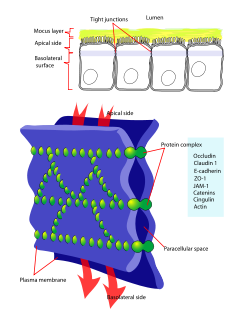- Tight junction
-
Tight junction 
Diagram of Tight junction Latin junctio occludens Code TH H1.00.01.1.02007 Tight junctions, or zonula occludens, are the closely associated areas of two cells whose membranes join together forming a virtually impermeable barrier to fluid. It is a type of junctional complex present only in vertebrates. The corresponding junctions that occur in invertebrates are septate junctions.
Contents
Structure
Tight junctions are composed of a branching network of sealing strands, each strand acting independently from the others. Therefore, the efficiency of the junction in preventing ion passage increases exponentially with the number of strands[citation needed]. Each strand is formed from a row of transmembrane proteins embedded in both plasma membranes, with extracellular domains joining one another directly. Although more proteins are present, the major types are the claudins and the occludins. These associate with different peripheral membrane proteins located on the intracellular side of plasma membrane, which anchor the strands to the actin component of the cytoskeleton. Thus, tight junctions join together the cytoskeletons of adjacent cells.
Functions
They perform vital functions:
- They hold cells together.
- Barrier function, which can be further subdivided into protective barriers and functional barriers serving purposes such as material transport and maintenance of osmotic balance:
- They help to maintain the polarity of cells by preventing the lateral diffusion of integral membrane proteins between the apical and lateral/basal surfaces, allowing the specialized functions of each surface (for example receptor-mediated endocytosis at the apical surface and exocytosis at the basolateral surface) to be preserved. This aims to preserve the transcellular transport.
- They prevent the passage of molecules and ions through the space between cells. So materials must actually enter the cells (by diffusion or active transport) in order to pass through the tissue. This pathway provides control over what substances are allowed through. (Tight junctions play this role in maintaining the blood-brain barrier.) At the present time, it is still unclear whether the control is active or passive and how these pathways are formed. In one study for paracellular transport across the tight junction in kidney proximal tubule, a dual pathway model is proposed: large slit breaks formed by infrequent discontinuities in the TJ complex and numerous small circular pores.[1]
In human physiology there are two main types of epithelia using distinct types of barrier mechanism. Dermal structures such as skin form a barrier from many layers of keratinised squamous cells. Internal epithelia on the other hand more often rely on tight cells junctions for their barrier function. This kind of barriers is mostly formed by only one or two layers of cells. Until recently it was not clear whether tight cell junctions also play any role in the barrier function of the skin and similar external epithelia, recent research suggests that this is indeed the case.
Classification
Epithelia are classed as 'tight' or 'leaky' depending on the ability of the tight junctions to prevent water and solute movement:
- Tight epithelia have tight junctions that prevent most movement between cells. An example of a tight epithelium is the distal convoluted tubule, and the collecting duct part of the nephron in the kidney.
- Leaky epithelia do not have these tight junctions, or have less complex tight junctions. For instance, the tight junction in the kidney proximal tubule, a very leaky epithelium, has only two to three junctional strands, and these strands exhibit infrequent large slit breaks.
See also
References
- ^ Guo, Weinbaum and Weinstein. A dual-pathway ultrastructural model for the tight junction of rat proximal tubule epithelium. Am. J. Physiol.: Renal Physiol., 285: F241-F257, 2003
External links
- An Overview of the Tight Junction at Zonapse.Net
- Occludin in Focus at Zonapse.Net
- MeSH Tight+Junctions
- Histology at BU 20502loa
Histology: Epithelial proteins (TH H1.00.01.1) Lateral/cell-cell Cell adhesion molecules: Adherens junction (Cadherin) · Desmosome (Desmoglein)
Ion channels: Gap junction/Connexon (Connexin)
Cytoskeleton: Desmosome (Desmoplakin, Plakoglobin, Tonofibril)
other membrane proteins: Tight junction (Claudin, Occludin, MARVELD2)Basal/cell-matrix Apical Categories:- Cell anatomy
- Cell biology stubs
Wikimedia Foundation. 2010.


